radio SKODA OCTAVIA 2011 2.G / (1Z) Columbus Navigation System Manual
[x] Cancel search | Manufacturer: SKODA, Model Year: 2011, Model line: OCTAVIA, Model: SKODA OCTAVIA 2011 2.G / (1Z)Pages: 47, PDF Size: 1.09 MB
Page 4 of 47
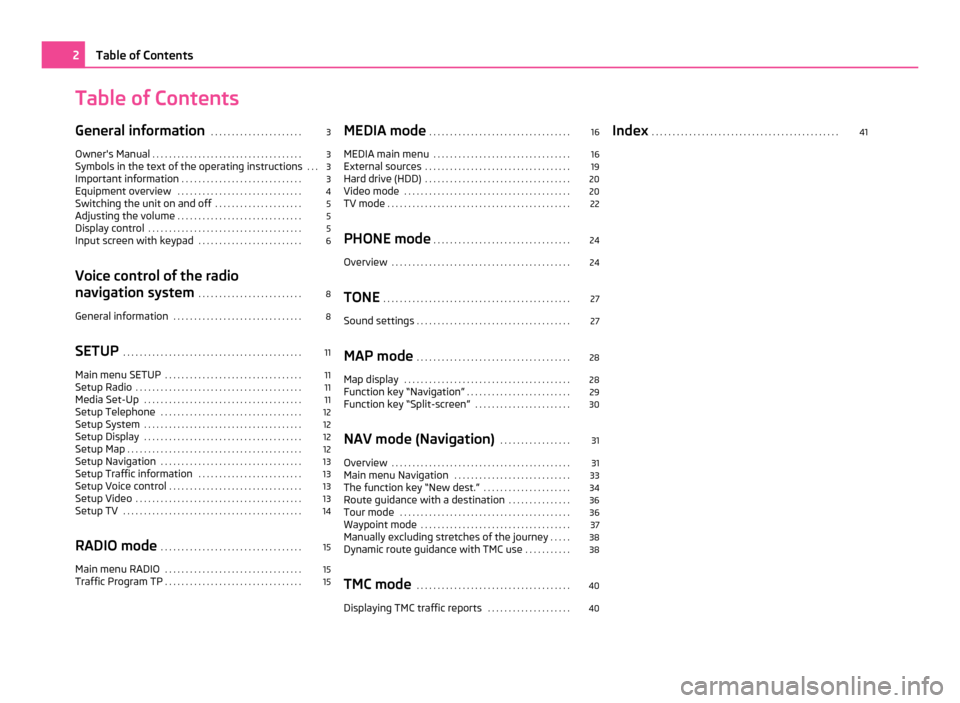
Table of Contents
General information
. . . . . . . . . . . . . . . . . . . . . . 3
Owner's Manual . . . . . . . . . . . . . . . . . . . . . . . . . . . . . . . . . . . . 3
Symbols in the text of the operating instructions . . . 3
Important information . . . . . . . . . . . . . . . . . . . . . . . . . . . . . 3
Equipment overview . . . . . . . . . . . . . . . . . . . . . . . . . . . . . . 4
Switching the unit on and off . . . . . . . . . . . . . . . . . . . . . 5
Adjusting the volume . . . . . . . . . . . . . . . . . . . . . . . . . . . . . . 5
Display control . . . . . . . . . . . . . . . . . . . . . . . . . . . . . . . . . . . . . 5
Input screen with keypad . . . . . . . . . . . . . . . . . . . . . . . . . 6
Voice control of the radio
navigation system . . . . . . . . . . . . . . . . . . . . . . . . . 8
General information . . . . . . . . . . . . . . . . . . . . . . . . . . . . . . . 8
SETUP . . . . . . . . . . . . . . . . . . . . . . . . . . . . . . . . . . . . . . . . . . . 11
Main menu SETUP . . . . . . . . . . . . . . . . . . . . . . . . . . . . . . . . . 11
Setup Radio . . . . . . . . . . . . . . . . . . . . . . . . . . . . . . . . . . . . . . . . 11
Media Set-Up . . . . . . . . . . . . . . . . . . . . . . . . . . . . . . . . . . . . . . 11
Setup Telephone . . . . . . . . . . . . . . . . . . . . . . . . . . . . . . . . . . 12
Setup System . . . . . . . . . . . . . . . . . . . . . . . . . . . . . . . . . . . . . . 12
Setup Display . . . . . . . . . . . . . . . . . . . . . . . . . . . . . . . . . . . . . . 12
Setup Map . . . . . . . . . . . . . . . . . . . . . . . . . . . . . . . . . . . . . . . . . . 12
Setup Navigation . . . . . . . . . . . . . . . . . . . . . . . . . . . . . . . . . . 13
Setup Traffic information . . . . . . . . . . . . . . . . . . . . . . . . . 13
Setup Voice control . . . . . . . . . . . . . . . . . . . . . . . . . . . . . . . . 13
Setup Video . . . . . . . . . . . . . . . . . . . . . . . . . . . . . . . . . . . . . . . . 13
Setup TV . . . . . . . . . . . . . . . . . . . . . . . . . . . . . . . . . . . . . . . . . . . 14
RADIO mode . . . . . . . . . . . . . . . . . . . . . . . . . . . . . . . . . . 15
Main menu RADIO . . . . . . . . . . . . . . . . . . . . . . . . . . . . . . . . . 15
Traffic Program TP . . . . . . . . . . . . . . . . . . . . . . . . . . . . . . . . . 15MEDIA mode
. . . . . . . . . . . . . . . . . . . . . . . . . . . . . . . . . . 16
MEDIA main menu . . . . . . . . . . . . . . . . . . . . . . . . . . . . . . . . . 16
External sources . . . . . . . . . . . . . . . . . . . . . . . . . . . . . . . . . . . 19
Hard drive (HDD) . . . . . . . . . . . . . . . . . . . . . . . . . . . . . . . . . . . 20
Video mode . . . . . . . . . . . . . . . . . . . . . . . . . . . . . . . . . . . . . . . . 20
TV mode . . . . . . . . . . . . . . . . . . . . . . . . . . . . . . . . . . . . . . . . . . . . 22
PHONE mode . . . . . . . . . . . . . . . . . . . . . . . . . . . . . . . . . 24
Overview . . . . . . . . . . . . . . . . . . . . . . . . . . . . . . . . . . . . . . . . . . . 24
TONE . . . . . . . . . . . . . . . . . . . . . . . . . . . . . . . . . . . . . . . . . . . . . 27
Sound settings . . . . . . . . . . . . . . . . . . . . . . . . . . . . . . . . . . . . . 27
MAP mode . . . . . . . . . . . . . . . . . . . . . . . . . . . . . . . . . . . . . 28
Map display . . . . . . . . . . . . . . . . . . . . . . . . . . . . . . . . . . . . . . . . 28
Function key “Navigation” . . . . . . . . . . . . . . . . . . . . . . . . . 29
Function key “Split-screen” . . . . . . . . . . . . . . . . . . . . . . . 30
NAV mode (Navigation) . . . . . . . . . . . . . . . . . 31
Overview . . . . . . . . . . . . . . . . . . . . . . . . . . . . . . . . . . . . . . . . . . . 31
Main menu Navigation . . . . . . . . . . . . . . . . . . . . . . . . . . . . 33
The function key “New dest.” . . . . . . . . . . . . . . . . . . . . . 34
Route guidance with a destination . . . . . . . . . . . . . . . 36
Tour mode . . . . . . . . . . . . . . . . . . . . . . . . . . . . . . . . . . . . . . . . . 36
Waypoint mode . . . . . . . . . . . . . . . . . . . . . . . . . . . . . . . . . . . . 37
Manually excluding stretches of the journey . . . . . 38
Dynamic route guidance with TMC use . . . . . . . . . . . 38
TMC mode . . . . . . . . . . . . . . . . . . . . . . . . . . . . . . . . . . . . . 40
Displaying TMC traffic reports . . . . . . . . . . . . . . . . . . . . 40Index
. . . . . . . . . . . . . . . . . . . . . . . . . . . . . . . . . . . . . . . . . . . . . 412
Table of Contents
Page 5 of 47
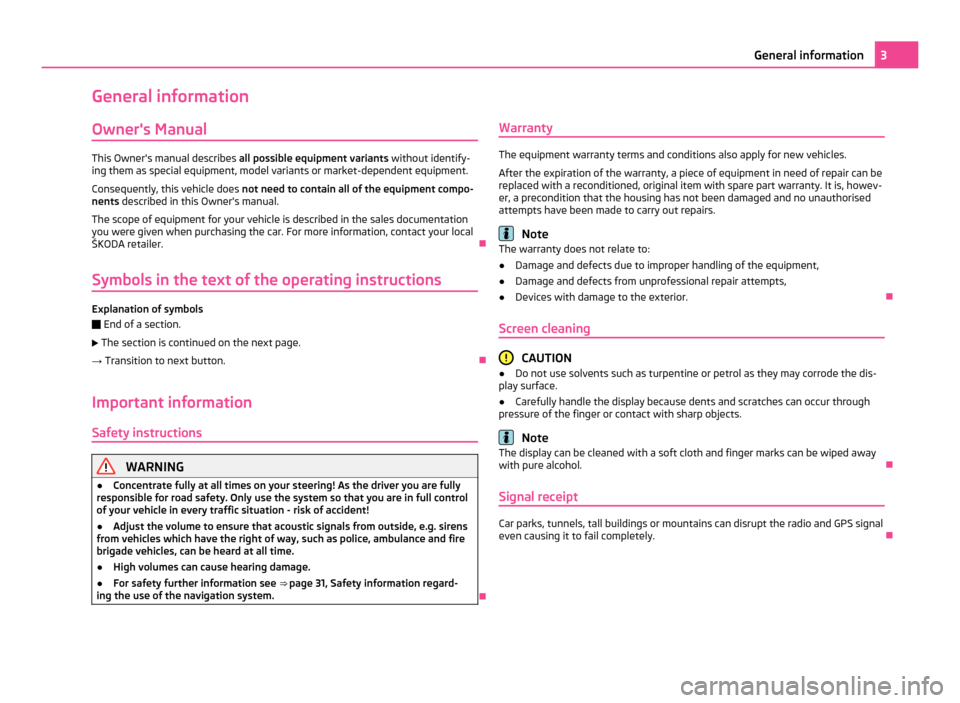
General information
Owner's Manual This Owner's manual describes
all possible equipment variants without identify-
ing them as special equipment, model variants or market-dependent equipment.
Consequently, this vehicle does not need to contain all of the equipment compo-
nents described in this Owner's manual.
The scope of equipment for your vehicle is described in the sales documentation
you were given when purchasing the car. For more information, contact your local
ŠKODA retailer. Ð
Symbols in the text of the operating instructions Explanation of symbols
Ð
End of a section.
The section is continued on the next page.
→ Transition to next button. Ð
Important information Safety instructions WARNING
● Concentrate fully at all times on your steering! As the driver you are fully
responsible for road safety. Only use the system so that you are in full control
of your vehicle in every traffic situation - risk of accident!
● Adjust the volume to ensure that acoustic signals from outside, e.g. sirens
from vehicles which have the right of way, such as police, ambulance and fire
brigade vehicles, can be heard at all time.
● High volumes can cause hearing damage.
● For safety further information see ⇒ page 31, Safety information regard-
ing the use of the navigation system . ÐWarranty The equipment warranty terms and conditions also apply for new vehicles.
After the expiration of the warranty, a piece of equipment in need of repair can be
replaced with a reconditioned, original item with spare part warranty. It is, howev-
er, a precondition that the housing has not been damaged and no unauthorised
attempts have been made to carry out repairs. Note
The warranty does not relate to:
● Damage and defects due to improper handling of the equipment,
● Damage and defects from unprofessional repair attempts,
● Devices with damage to the exterior. Ð
Screen cleaning CAUTION
● Do not use solvents such as turpentine or petrol as they may corrode the dis-
play surface.
● Carefully handle the display because dents and scratches can occur through
pressure of the finger or contact with sharp objects. Note
The display can be cleaned with a soft cloth and finger marks can be wiped away
with pure alcohol. Ð
Signal receipt Car parks, tunnels, tall buildings or mountains can disrupt the radio and GPS signal
even causing it to fail completely.
Ð 3
General information
Page 6 of 47
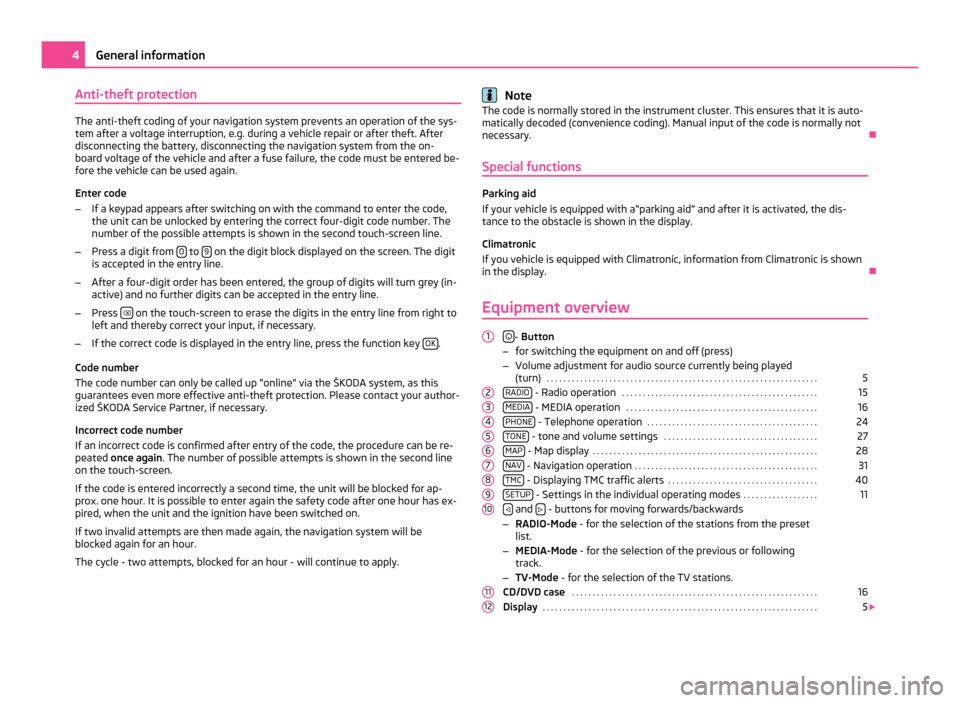
Anti-theft protection
The anti-theft coding of your navigation system prevents an operation of the sys-
tem after a voltage interruption, e.g. during a vehicle repair or after theft. After
disconnecting the battery, disconnecting the navigation system from the on-
board voltage of the vehicle and after a fuse failure, the code must be entered be-
fore the vehicle can be used again.
Enter code
– If a keypad appears after switching on with the command to enter the code,
the unit can be unlocked by entering the correct four-digit code number. The
number of the possible attempts is shown in the second touch-screen line.
– Press a digit from 0 to
9 on the digit block displayed on the screen. The digit
is accepted in the entry line.
– After a four-digit order has been entered, the group of digits will turn grey (in-
active) and no further digits can be accepted in the entry line.
– Press on the touch-screen to erase the digits in the entry line from right to
left and thereby correct your input, if necessary.
– If the correct code is displayed in the entry line, press the function key OK .
Code number
The code number can only be called up
“online” via the ŠKODA system, as this
guarantees even more effective anti-theft protection. Please contact your author-
ized ŠKODA Service Partner, if necessary.
Incorrect code number
If an incorrect code is confirmed after entry of the code, the procedure can be re-
peated once again . The number of possible attempts is shown in the second line
on the touch-screen.
If the code is entered incorrectly a second time, the unit will be blocked for ap-
prox. one hour. It is possible to enter again the safety code after one hour has ex-
pired, when the unit and the ignition have been switched on.
If two invalid attempts are then made again, the navigation system will be
blocked again for an hour.
The cycle - two attempts, blocked for an hour - will continue to apply. Note
The code is normally stored in the instrument cluster. This ensures that it is auto-
matically decoded (convenience coding). Manual input of the code is normally not
necessary. Ð
Special functions Parking aid
If your vehicle is equipped with a
“parking aid” and after it is activated, the dis-
tance to the obstacle is shown in the display.
Climatronic
If you vehicle is equipped with Climatronic, information from Climatronic is shown
in the display. Ð
Equipment overview
- Button
– for switching the equipment on and off (press)
– Volume adjustment for audio source currently being played
(turn) . . . . . . . . . . . . . . . . . . . . . . . . . . . . . . . . . . . . . . . . . . . . . . . . . . . . . . . . . . . . . . . . .
5
RADIO - Radio operation
. . . . . . . . . . . . . . . . . . . . . . . . . . . . . . . . . . . . . . . . . . . . . . .
15
MEDIA - MEDIA operation
. . . . . . . . . . . . . . . . . . . . . . . . . . . . . . . . . . . . . . . . . . . . . .
16
PHONE - Telephone operation
. . . . . . . . . . . . . . . . . . . . . . . . . . . . . . . . . . . . . . . . .
24
TONE - tone and volume settings
. . . . . . . . . . . . . . . . . . . . . . . . . . . . . . . . . . . . .
27
MAP - Map display
. . . . . . . . . . . . . . . . . . . . . . . . . . . . . . . . . . . . . . . . . . . . . . . . . . . . . .
28
NAV - Navigation operation
. . . . . . . . . . . . . . . . . . . . . . . . . . . . . . . . . . . . . . . . . . . .
31
TMC - Displaying TMC traffic alerts
. . . . . . . . . . . . . . . . . . . . . . . . . . . . . . . . . . . .
40
SETUP - Settings in the individual operating modes
. . . . . . . . . . . . . . . . . .
11
and
- buttons for moving forwards/backwards
– RADIO-Mode - for the selection of the stations from the preset
list.
– MEDIA-Mode - for the selection of the previous or following
track.
– TV-Mode - for the selection of the TV stations.
CD/DVD case . . . . . . . . . . . . . . . . . . . . . . . . . . . . . . . . . . . . . . . . . . . . . . . . . . . . . . . . . . . 16
Display . . . . . . . . . . . . . . . . . . . . . . . . . . . . . . . . . . . . . . . . . . . . . . . . . . . . . . . . . . . . . . . . . . 5
1
2
3
4
5
6
7
8
9
10
11
124
General information
Page 7 of 47
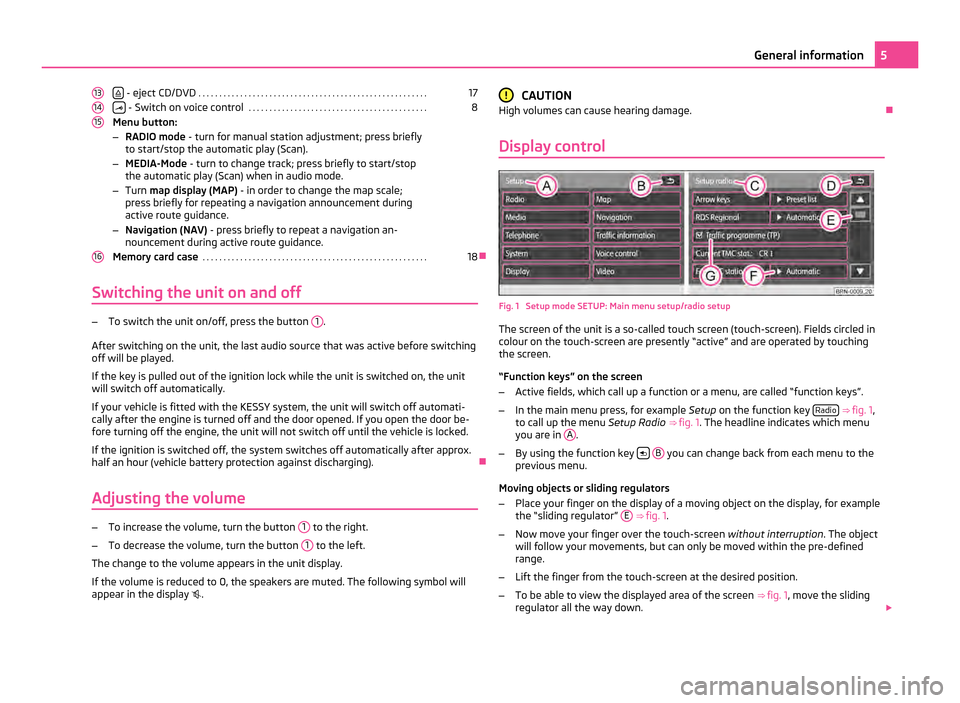
- eject CD/DVD
. . . . . . . . . . . . . . . . . . . . . . . . . . . . . . . . . . . . . . . . . . . . . . . . . . . . . . . 17
- Switch on voice control
. . . . . . . . . . . . . . . . . . . . . . . . . . . . . . . . . . . . . . . . . . . 8
Menu button:
– RADIO mode - turn for manual station adjustment; press briefly
to start/stop the automatic play (Scan).
– MEDIA-Mode - turn to change track; press briefly to start/stop
the automatic play (Scan) when in audio mode.
– Turn map display (MAP) - in order to change the map scale;
press briefly for repeating a navigation announcement during
active route guidance.
– Navigation (NAV) - press briefly to repeat a navigation an-
nouncement during active route guidance.
Memory card case . . . . . . . . . . . . . . . . . . . . . . . . . . . . . . . . . . . . . . . . . . . . . . . . . . . . . . 18Ð
Switching the unit on and off –
To switch the unit on/off, press the button 1 .
After switching on the unit, the last audio source that was active before switching
off will be played.
If the key is pulled out of the ignition lock while the unit is switched on, the unit
will switch off automatically.
If your vehicle is fitted with the KESSY system, the unit will switch off automati-
cally after the engine is turned off and the door opened. If you open the door be-
fore turning off the engine, the unit will not switch off until the vehicle is locked.
If the ignition is switched off, the system switches off automatically after approx.
half an hour (vehicle battery protection against discharging). Ð
Adjusting the volume –
To increase the volume, turn the button 1 to the right.
– To decrease the volume, turn the button 1 to the left.
The change to the volume appears in the unit display.
If the volume is reduced to 0, the speakers are muted. The following symbol will
appear in the display .
13 14
15
16 CAUTION
High volumes can cause hearing damage. Ð
Display control Fig. 1 Setup mode SETUP: Main menu setup/radio setup
The screen of the unit is a so-called touch screen (touch-screen). Fields circled in
colour on the touch-screen are presently
“active” and are operated by touching
the screen.
“Function keys” on the screen
– Active fields, which call up a function or a menu, are called “function keys”.
– In the main menu press, for example Setup on the function key Radio
⇒ fig. 1 ,
to call up the menu Setup Radio ⇒ fig. 1 . The headline indicates which menu
you are in A .
– By using the function key
B you can change back from each menu to the
previous menu.
Moving objects or sliding regulators
– Place your finger on the display of a moving object on the display, for example
the “sliding regulator
” E
⇒ fig. 1.
– Now move your finger over the touch-screen without interruption. The object
will follow your movements, but can only be moved within the pre-defined
range.
– Lift the finger from the touch-screen at the desired position.
– To be able to view the displayed area of the screen ⇒ fig. 1 , move the sliding
regulator all the way down. 5
General information
Page 10 of 47
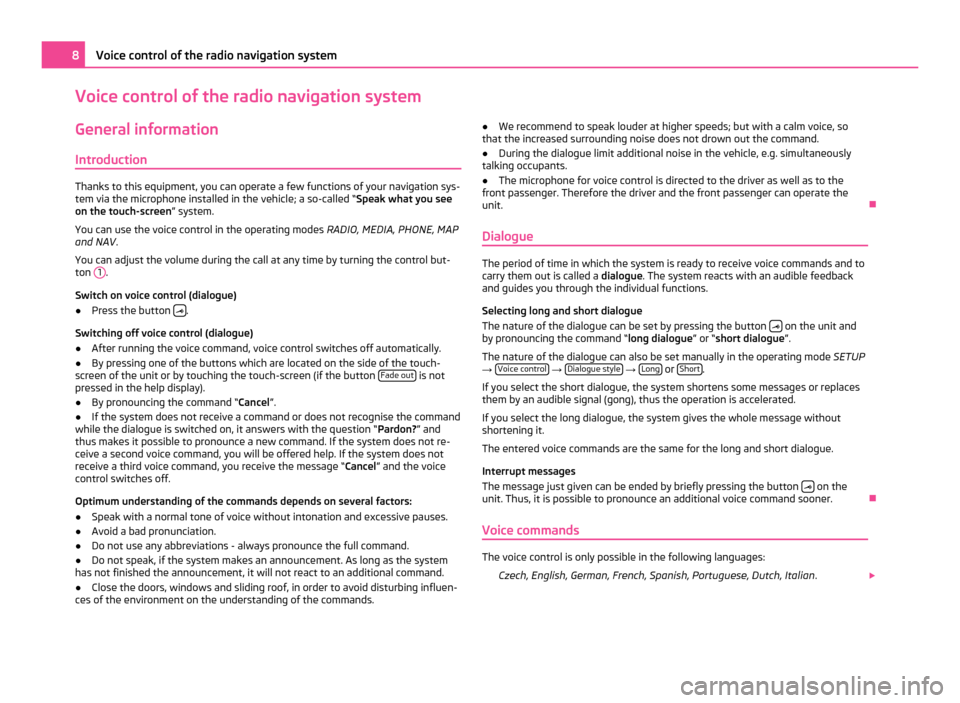
Voice control of the radio navigation system
General information
Introduction Thanks to this equipment, you can operate a few functions of your navigation sys-
tem via the microphone installed in the vehicle; a so-called “Speak what you see
on the touch-screen” system.
You can use the voice control in the operating modes RADIO, MEDIA, PHONE, MAP
and NAV .
You can adjust the volume during the call at any time by turning the control but-
ton 1 .
Switch on voice control (dialogue)
● Press the button .
Switching off voice control (dialogue)
● After running the voice command, voice control switches off automatically.
● By pressing one of the buttons which are located on the side of the touch-
screen of the unit or by touching the touch-screen (if the button Fade out is not
pressed in the help display).
● By pronouncing the command “Cancel ”.
● If the system does not receive a command or does not recognise the command
while the dialogue is switched on, it answers with the question
“Pardon?” and
thus makes it possible to pronounce a new command. If the system does not re-
ceive a second voice command, you will be offered help. If the system does not
receive a third voice command, you receive the message “ Cancel” and the voice
control switches off.
Optimum understanding of the commands depends on several factors:
● Speak with a normal tone of voice without intonation and excessive pauses.
● Avoid a bad pronunciation.
● Do not use any abbreviations - always pronounce the full command.
● Do not speak, if the system makes an announcement. As long as the system
has not finished the announcement, it will not react to an additional command.
● Close the doors, windows and sliding roof, in order to avoid disturbing influen-
ces of the environment on the understanding of the commands. ●
We recommend to speak louder at higher speeds; but with a calm voice, so
that the increased surrounding noise does not drown out the command.
● During the dialogue limit additional noise in the vehicle, e.g. simultaneously
talking occupants.
● The microphone for voice control is directed to the driver as well as to the
front passenger. Therefore the driver and the front passenger can operate the
unit. Ð
Dialogue The period of time in which the system is ready to receive voice commands and to
carry them out is called a
dialogue. The system reacts with an audible feedback
and guides you through the individual functions.
Selecting long and short dialogue
The nature of the dialogue can be set by pressing the button on the unit and
by pronouncing the command
“long dialogue ” or “short dialogue ”.
The nature of the dialogue can also be set manually in the operating mode SETUP
→ Voice control →
Dialogue style →
Long or
Short .
If you select the short dialogue, the system shortens some messages or replaces
them by an audible signal (gong), thus the operation is accelerated.
If you select the long dialogue, the system gives the whole message without
shortening it.
The entered voice commands are the same for the long and short dialogue.
Interrupt messages
The message just given can be ended by briefly pressing the button on the
unit. Thus, it is possible to pronounce an additional voice command sooner. Ð
Voice commands The voice control is only possible in the following languages:
Czech, English, German, French, Spanish, Portuguese, Dutch, Italian .8
Voice control of the radio navigation system
Page 11 of 47
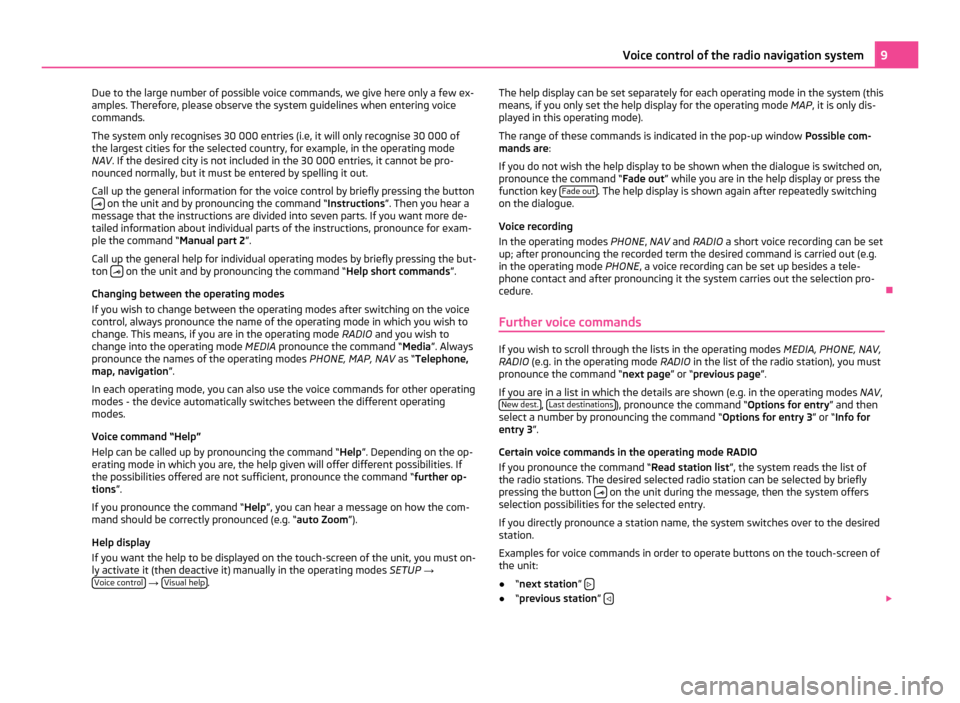
Due to the large number of possible voice commands, we give here only a few ex-
amples. Therefore, please observe the system guidelines when entering voice
commands.
The system only recognises 30 000 entries (i.e, it will only recognise 30 000 of
the largest cities for the selected country, for example, in the operating mode
NAV
. If the desired city is not included in the 30 000 entries, it cannot be pro-
nounced normally, but it must be entered by spelling it out.
Call up the general information for the voice control by briefly pressing the button on the unit and by pronouncing the command “Instructions”. Then you hear a
message that the instructions are divided into seven parts. If you want more de-
tailed information about individual parts of the instructions, pronounce for exam-
ple the command
“Manual part 2”.
Call up the general help for individual operating modes by briefly pressing the but-
ton on the unit and by pronouncing the command “Help short commands”
.
Changing between the operating modes
If you wish to change between the operating modes after switching on the voice
control, always pronounce the name of the operating mode in which you wish to
change. This means, if you are in the operating mode RADIO and you wish to
change into the operating mode MEDIA pronounce the command “Media”. Always
pronounce the names of the operating modes PHONE, MAP, NAV as “Telephone,
map, navigation ”.
In each operating mode, you can also use the voice commands for other operating
modes - the device automatically switches between the different operating
modes.
Voice command “Help”
Help can be called up by pronouncing the command “ Help”. Depending on the op-
erating mode in which you are, the help given will offer different possibilities. If
the possibilities offered are not sufficient, pronounce the command “further op-
tions”.
If you pronounce the command “Help”, you can hear a message on how the com-
mand should be correctly pronounced (e.g. “auto Zoom ”).
Help display
If you want the help to be displayed on the touch-screen of the unit, you must on-
ly activate it (then deactive it) manually in the operating modes SETUP → Voice control →
Visual help . The help display can be set separately for each operating mode in the system (this
means, if you only set the help display for the operating mode
MAP, it is only dis-
played in this operating mode).
The range of these commands is indicated in the pop-up window Possible com-
mands are:
If you do not wish the help display to be shown when the dialogue is switched on,
pronounce the command
“Fade out” while you are in the help display or press the
function key Fade out . The help display is shown again after repeatedly switching
on the dialogue.
Voice recording
In the operating modes PHONE, NAV and RADIO a short voice recording can be set
up; after pronouncing the recorded term the desired command is carried out (e.g.
in the operating mode PHONE, a voice recording can be set up besides a tele-
phone contact and after pronouncing it the system carries out the selection pro-
cedure. Ð
Further voice commands If you wish to scroll through the lists in the operating modes
MEDIA, PHONE, NAV,
RADIO (e.g. in the operating mode RADIO in the list of the radio station), you must
pronounce the command
“next page” or “previous page”.
If you are in a list in which the details are shown (e.g. in the operating modes NAV,
New dest. ,
Last destinations ), pronounce the command “Options for entry
” and then
select a number by pronouncing the command
“Options for entry 3” or “Info for
entry 3 ”.
Certain voice commands in the operating mode RADIO
If you pronounce the command “Read station list ”, the system reads the list of
the radio stations. The desired selected radio station can be selected by briefly
pressing the button on the unit during the message, then the system offers
selection possibilities for the selected entry.
If you directly pronounce a station name, the system switches over to the desired
station.
Examples for voice commands in order to operate buttons on the touch-screen of
the unit:
● “next station ” ●
“previous station” 9
Voice control of the radio navigation system
Page 12 of 47
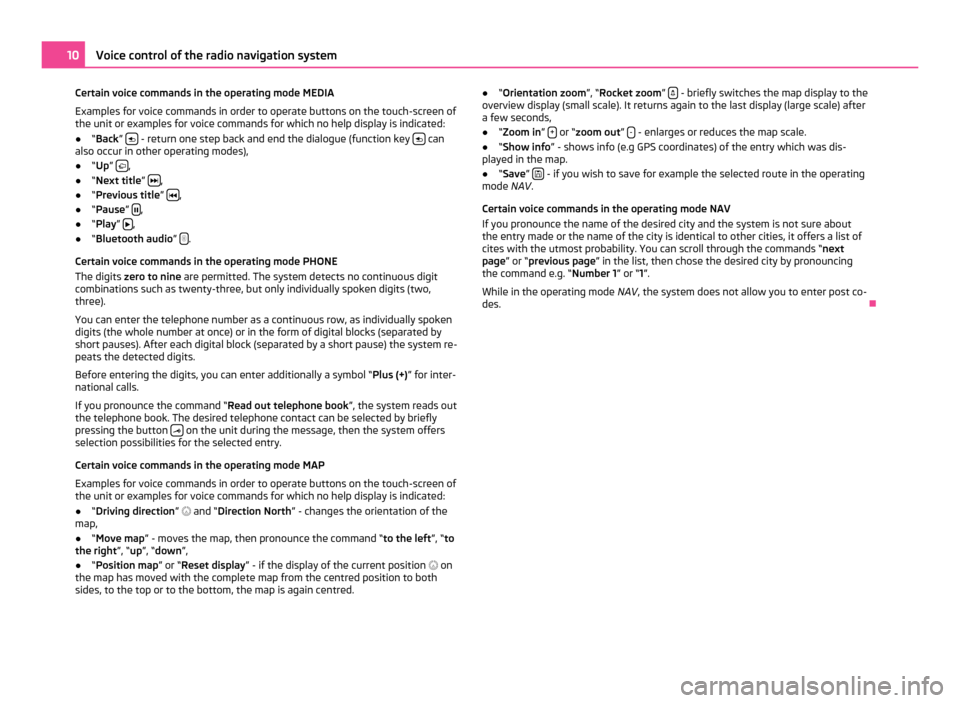
Certain voice commands in the operating mode MEDIA
Examples for voice commands in order to operate buttons on the touch-screen of
the unit or examples for voice commands for which no help display is indicated:
● “Back” - return one step back and end the dialogue (function key
can
also occur in other operating modes),
● “Up ” ,
● “Next title ” ,
● “Previous title ” ,
● “Pause” ,
● “Play ”
,
● “Bluetooth audio ” .
Certain voice commands in the operating mode PHONE
The digits zero to nine are permitted. The system detects no continuous digit
combinations such as twenty-three, but only individually spoken digits (two,
three).
You can enter the telephone number as a continuous row, as individually spoken
digits (the whole number at once) or in the form of digital blocks (separated by
short pauses). After each digital block (separated by a short pause) the system re-
peats the detected digits.
Before entering the digits, you can enter additionally a symbol
“Plus (+)” for inter-
national calls.
If you pronounce the command “Read out telephone book ”, the system reads out
the telephone book. The desired telephone contact can be selected by briefly
pressing the button on the unit during the message, then the system offers
selection possibilities for the selected entry.
Certain voice commands in the operating mode MAP
Examples for voice commands in order to operate buttons on the touch-screen of
the unit or examples for voice commands for which no help display is indicated:
● “Driving direction ” and “Direction North ” - changes the orientation of the
map,
● “Move map ”
- moves the map, then pronounce the command “ to the left”, “to
the right”, “up”, “down”,
● “Position map ” or “Reset display” - if the display of the current position on
the map has moved with the complete map from the centred position to both
sides, to the top or to the bottom, the map is again centred. ●
“Orientation zoom ”
, “Rocket zoom” - briefly switches the map display to the
overview display (small scale). It returns again to the last display (large scale) after
a few seconds,
● “Zoom in” + or “zoom out”
- - enlarges or reduces the map scale.
● “Show info ” - shows info (e.g GPS coordinates) of the entry which was dis-
played in the map.
● “Save ”
- if you wish to save for example the selected route in the operating
mode NAV .
Certain voice commands in the operating mode NAV
If you pronounce the name of the desired city and the system is not sure about
the entry made or the name of the city is identical to other cities, it offers a list of
cites with the utmost probability. You can scroll through the commands
“next
page” or “ previous page” in the list, then chose the desired city by pronouncing
the command e.g. “Number 1 ” or “1”.
While in the operating mode NAV, the system does not allow you to enter post co-
des. Ð10
Voice control of the radio navigation system
Page 13 of 47
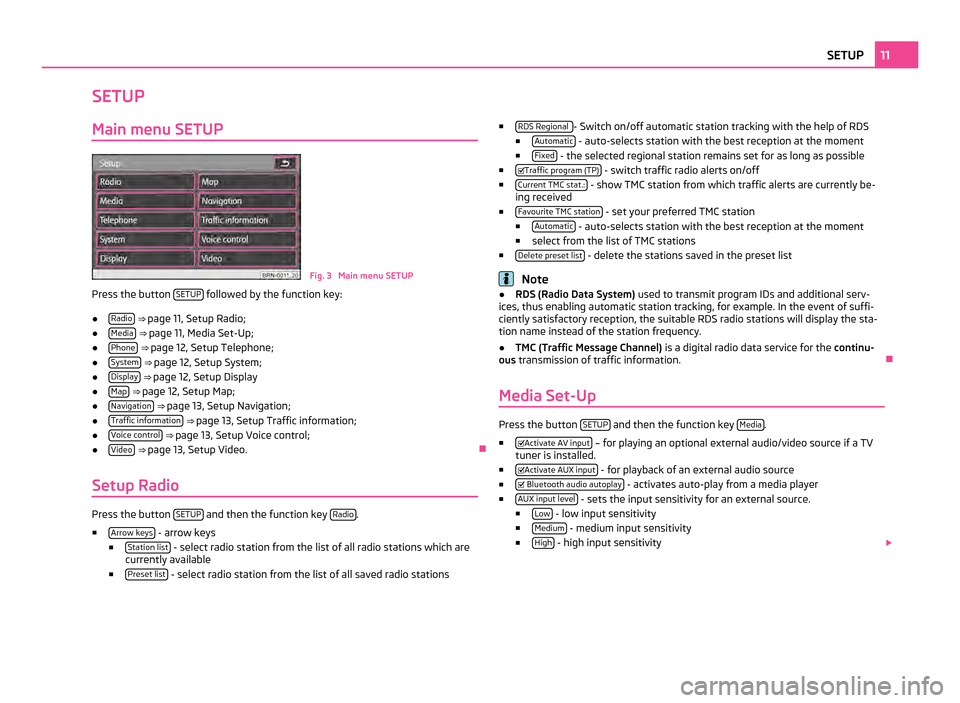
SETUP
Main menu SETUP Fig. 3 Main menu SETUP
Press the button SETUP followed by the function key:
● Radio
⇒ page 11, Setup Radio;
● Media
⇒ page 11, Media Set-Up ;
● Phone
⇒ page 12, Setup Telephone;
● System
⇒ page 12, Setup System;
● Display
⇒ page 12, Setup Display
● Map
⇒ page 12, Setup Map ;
● Navigation
⇒ page 13, Setup Navigation;
● Traffic information
⇒ page 13, Setup Traffic information;
● Voice control
⇒ page 13, Setup Voice control;
● Video
⇒ page 13, Setup Video. Ð
Setup Radio Press the button
SETUP and then the function key
Radio .
■ Arrow keys - arrow keys
■ Station list - select radio station from the list of all radio stations which are
currently available
■ Preset list - select radio station from the list of all saved radio stations ■
RDS Regional - Switch on/off automatic station tracking with the help of RDS
■ Automatic - auto-selects station with the best reception at the moment
■ Fixed - the selected regional station remains set for as long as possible
■ Traffic program (TP) - switch traffic radio alerts on/off
■ Current TMC stat.: - show TMC station from which traffic alerts are currently be-
ing received
■ Favourite TMC station - set your preferred TMC station
■ Automatic - auto-selects station with the best reception at the moment
■ select from the list of TMC stations
■ Delete preset list - delete the stations saved in the preset list
Note
● RDS (Radio Data System) used to transmit program IDs and additional serv-
ices, thus enabling automatic station tracking, for example. In the event of suffi-
ciently satisfactory reception, the suitable RDS radio stations will display the sta-
tion name instead of the station frequency.
● TMC (Traffic Message Channel)
is a digital radio data service for the continu-
ous transmission of traffic information. Ð
Media Set-Up Press the button
SETUP and then the function key
Media .
■ Activate AV input – for playing an optional external audio/video source if a TV
tuner is installed.
■ Activate AUX input - for playback of an external audio source
■ Bluetooth audio autoplay - activates auto-play from a media player
■ AUX input level - sets the input sensitivity for an external source.
■ Low - low input sensitivity
■ Medium - medium input sensitivity
■ High - high input sensitivity
11
SETUP
Page 14 of 47
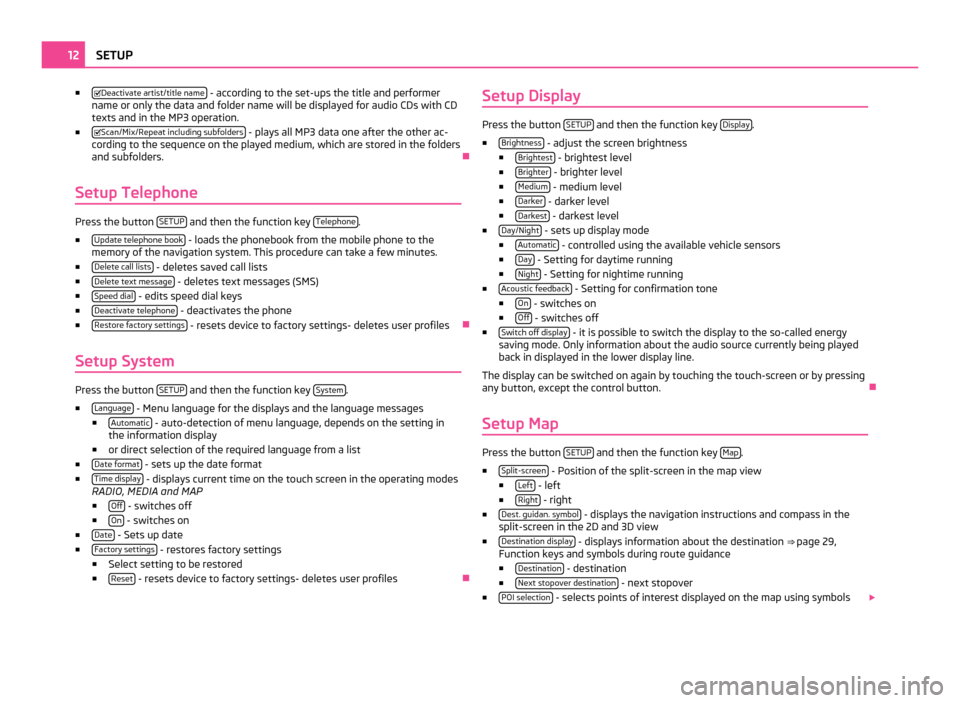
■
Deactivate artist/title name - according to the set-ups the title and performer
name or only the data and folder name will be displayed for audio CDs with CD
texts and in the MP3 operation.
■ Scan/Mix/Repeat including subfolders - plays all MP3 data one after the other ac-
cording to the sequence on the played medium, which are stored in the folders
and subfolders. Ð
Setup Telephone Press the button
SETUP and then the function key
Telephone .
■ Update telephone book - loads the phonebook from the mobile phone to the
memory of the navigation system. This procedure can take a few minutes.
■ Delete call lists - deletes saved call lists
■ Delete text message - deletes text messages (SMS)
■ Speed dial - edits speed dial keys
■ Deactivate telephone - deactivates the phone
■ Restore factory settings - resets device to factory settings- deletes user profiles
Ð
Setup System Press the button
SETUP and then the function key
System .
■ Language - Menu language for the displays and the language messages
■ Automatic - auto-detection of menu language, depends on the setting in
the information display
■ or direct selection of the required language from a list
■ Date format - sets up the date format
■ Time display - displays current time on the touch screen in the operating modes
RADIO, MEDIA and MAP
■ Off - switches off
■ On - switches on
■ Date - Sets up date
■ Factory settings - restores factory settings
■ Select setting to be restored
■ Reset - resets device to factory settings- deletes user profiles
ÐSetup Display Press the button
SETUP and then the function key
Display .
■ Brightness - adjust the screen brightness
■ Brightest - brightest level
■ Brighter - brighter level
■ Medium - medium level
■ Darker - darker level
■ Darkest - darkest level
■ Day/Night - sets up display mode
■ Automatic - controlled using the available vehicle sensors
■ Day - Setting for daytime running
■ Night - Setting for nightime running
■ Acoustic feedback - Setting for confirmation tone
■ On - switches on
■ Off - switches off
■ Switch off display - it is possible to switch the display to the so-called energy
saving mode. Only information about the audio source currently being played
back in displayed in the lower display line.
The display can be switched on again by touching the touch-screen or by pressing
any button, except the control button. Ð
Setup Map Press the button
SETUP and then the function key
Map .
■ Split-screen - Position of the split-screen in the map view
■ Left - left
■ Right - right
■ Dest. guidan. symbol - displays the navigation instructions and compass in the
split-screen in the 2D and 3D view
■ Destination display - displays information about the destination
⇒ page 29,
Function keys and symbols during route guidance
■ Destination - destination
■ Next stopover destination - next stopover
■ POI selection - selects points of interest displayed on the map using symbols
12
SETUP
Page 15 of 47
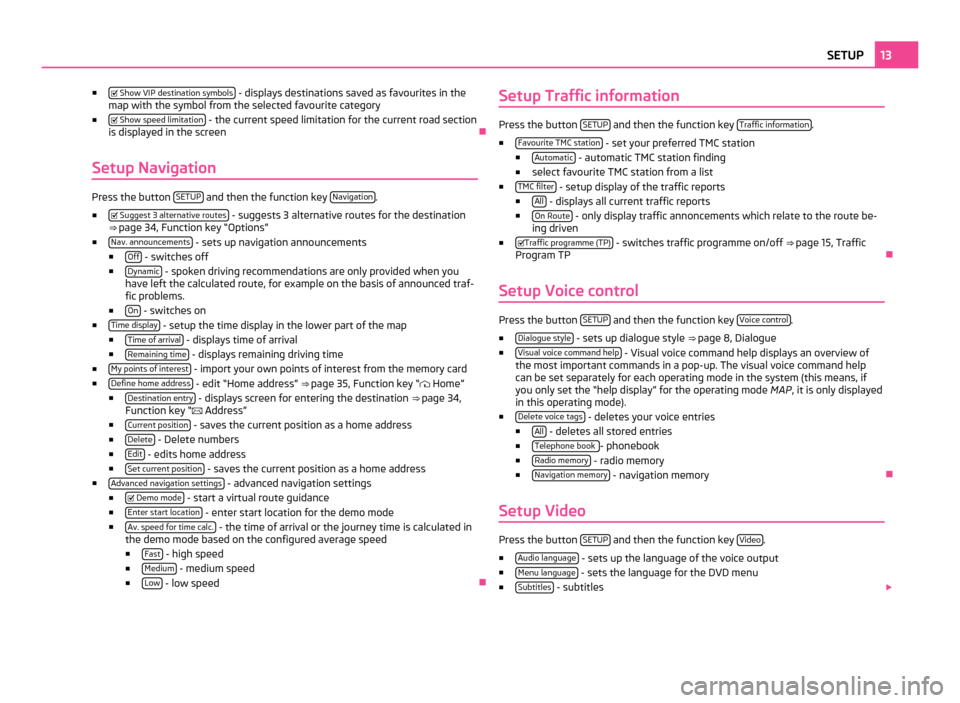
■
Show VIP destination symbols - displays destinations saved as favourites in the
map with the symbol from the selected favourite category
■ Show speed limitation - the current speed limitation for the current road section
is displayed in the screen Ð
Setup Navigation Press the button
SETUP and then the function key
Navigation .
■ Suggest 3 alternative routes - suggests 3 alternative routes for the destination
⇒ page 34, Function key
“Options”
■ Nav. announcements - sets up navigation announcements
■ Off - switches off
■ Dynamic - spoken driving recommendations are only provided when you
have left the calculated route, for example on the basis of announced traf-
fic problems.
■ On - switches on
■ Time display - setup the time display in the lower part of the map
■ Time of arrival - displays time of arrival
■ Remaining time - displays remaining driving time
■ My points of interest - import your own points of interest from the memory card
■ Define home address - edit “Home address”
⇒
page 35, Function key “ Home”
■ Destination entry - displays screen for entering the destination
⇒ page 34,
Function key “ Address”
■ Current position - saves the current position as a home address
■ Delete - Delete numbers
■ Edit - edits home address
■ Set current position - saves the current position as a home address
■ Advanced navigation settings - advanced navigation settings
■ Demo mode - start a virtual route guidance
■ Enter start location - enter start location for the demo mode
■ Av. speed for time calc. - the time of arrival or the journey time is calculated in
the demo mode based on the configured average speed
■ Fast - high speed
■ Medium - medium speed
■ Low - low speed
ÐSetup Traffic information Press the button
SETUP and then the function key
Traffic information .
■ Favourite TMC station - set your preferred TMC station
■ Automatic - automatic TMC station finding
■ select favourite TMC station from a list
■ TMC filter - setup display of the traffic reports
■ All - displays all current traffic reports
■ On Route - only display traffic annoncements which relate to the route be-
ing driven
■ Traffic programme (TP) - switches traffic programme on/off
⇒ page 15, Traffic
Program TP Ð
Setup Voice control Press the button
SETUP and then the function key
Voice control .
■ Dialogue style - sets up dialogue style
⇒ page 8, Dialogue
■ Visual voice command help - Visual voice command help displays an overview of
the most important commands in a pop-up. The visual voice command help
can be set separately for each operating mode in the system (this means, if
you only set the
“help display” for the operating mode MAP, it is only displayed
in this operating mode).
■ Delete voice tags - deletes your voice entries
■ All - deletes all stored entries
■ Telephone book - phonebook
■ Radio memory - radio memory
■ Navigation memory - navigation memory
Ð
Setup Video Press the button
SETUP and then the function key
Video .
■ Audio language - sets up the language of the voice output
■ Menu language - sets the language for the DVD menu
■ Subtitles - subtitles
13
SETUP